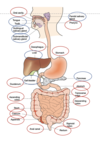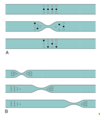Motility of the lower GIT Flashcards
(38 cards)
In the GIT which organs are accessory organs?
- those involved in secretion purposes
- liver
- pancrease
- gallbladder
- oral salivary glands and the tongue

What is the classification of the lower GIT?
- inferior to the suspensory muscle of the duodenum
- ligament of Treitz

What are the 4 main components of the lower GIT?
1 - small intestines
2 - large intestines
3 - rectum
4 - anus

What are the 3 parts of the small intestines, from top to bottom?
1 - duodenum = shortest
2 - jejunum = medium
3 - ileum = longest

Generally how long does digestion in the small intestines take?
- 3-5 hours
The small intestines (SI) has adapted and evolved to maximise digestion and absorption. How has the surface of the SI adapted to increase its surface area and this absorption?
- brush border micro villi

There are 2 types of motility in the small intestines, what are they?
1 - segmentation which is mixing and circulation providing maximum exposure to villi
2 - peristaltic contractions to propel chyme
During segmentation contractions of the GIT, what happens?
- mixing of chyme
- stretch receptors trigger myenteric muscle contraction

During segmentation contractions of the GIT, is there any net movement or is segmentation just to mix digesta?
- no net movement
- mixing only
During propulsive peristalsis of the GIT, is there any net movement or is segmentation just to mix digesta?
- movement of chyme through the digestive tract

During propulsive peristalsis how does the GIT know to contract and move chyme?
- stretch receptors trigger myenteric plexus stimulation of muscle contraction
- net movement forwards
In addition to stretch receptors activiting propulsive peristalsis, what else can contribute to GIT motility?
- hormones
- excitation via gastrin, CCK, insulin, motilin
- inhibition via secretin and glucagon
There are a number of propulsive peristalsis reflexes that are triggered once chyme enters the lower GIT, stretches the GIT and stimulates the mysenteric plexus. Gastroenteric reflex is one of those reflexes, what is this?
- gastric distention activates myenteric plexus
- this promotes peristalsis with small intestine

There are a number of propulsive peristalsis reflexes that are triggered once chyme enters the lower GIT, stretches the GIT and stimulates the mysenteric plexus. Gastroileal reflex is one of those reflexes, what is this?
- food in the stomach is recognised
- causes peristalsis in the ileum
- ileocecal valve opens and contents enter the large intestine

There are a number of propulsive peristalsis reflexes that are triggered once chyme enters the lower GIT, stretches the GIT and stimulates the mysenteric plexus. The migrating motor complex s one of those reflexes, what is this?
- a pattern of electrical activity in the lower GIT
- purpose is to move SI contents
- occur between meals (around every 90 minutes)
There are a number of propulsive peristalsis reflexes that are triggered once chyme enters the lower GIT, stretches the GIT and stimulates the mysenteric plexus. The migrating motor complex (MMC) is one of those reflexes. How is the MMC contriolled?
- intrinsic enteric control (no external stimulus needed)
- hormone motilin can also contribute
There are a number of propulsive peristalsis reflexes that are triggered once chyme enters the lower GIT, stretches the GIT and stimulates the mysenteric plexus. The migrating motor complex (MMC) is one of those reflexes. The MMC is not only important for movement of chyme, but it also has another important purpose, what is this?
- ensure there is no bacterial overgrowth
The enteric nervous system (ENS) is the intrinsic nervous system of the GIT and ensure mixing and peristalsis contractions. What are 2 alternative pathways that are able to module the mixing and peristaltic contractions of the large intestines?
1 - neural via autonomic nervous system
2 - hormonal secretions
How often does the large intestine have mass movement peristaltic contractions per day?
- 2-3 times per day
- moves stool into rectum
As the chyme moves through the large intestines, what is the large intestines doing to the properties of the chyme?
- extracting H2O
- changes chyme from liquid to faeces

What strutctural aspect of the large intestines are involved in the mixing of the chyme?
- haustra bulges

If there is poor motility of too much motility what can this do to the stool and symptoms for the patient?
- poor motility = constipation
- fast motility = diarrhea
Mass movements of the large intestines (LI) are facilitated by reflexes in the upper GIT. What 2 reflexes, that are triggered by stretch receptors in the upper GIT contribute to mass movements every 2-3 hours in the large intestines?
1 - gastro-colic reflexes
- food stretches stomach and initiates contraction of LI
2 - duodeno-colic reflexes
- duodenum is stretched with food and signals the LI
What is the defecation reflex?
- movement of faeces into the rectum (normally empty)
- rectum is stretched and activates the enteric nervous system (submucosa and myenteric plexus)
- stretch receptors also signal parasympathetic nervous system










